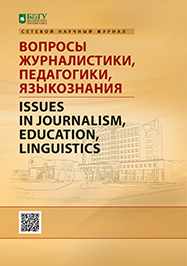Archetypal tropes in the structure of videoblogs
DOI:
https://doi.org/10.18413/2712-7451-2020-39-2-169-177Keywords:
archetype, trope, show, broadcast, videoblog, mediaAbstract
Despite significant transformations, we observe today in the informational space, the media
sphere has undergone few changes in its core content. The modern media is developing a new language
based on the newest technologies in the field of media-production but that rarely leads to changes in its
underline concepts and methods. In this regard, the author makes a comparative analysis of the plot features
of modern audiovisual content both in its television form and in the format of video blogs. The process of
modification of traditional archetypal stories in the context of modern media processes is studied. Examples
of their manifestation in traditional and modern media are given. The study identified the following
common archetypal stories: "the feat of Prometheus", "the Cinderella archetype", "sleeping beauty", "rock",
"systematization of philosophical categories", "adventure", "roguery", "natural disaster". Relying on
archetypal stories allows authors to cement a disparate audience, form a common media field both in
retrospect and from the perspective of modernity. Media texts are still carriers of cultural traditions,
translators of common socio-cultural codes, even in the most modern media formats. A feature that
distinguishes video bloggers from the authors of traditional TV content has been identified. If the latter seek
to find original forms within existing formats, the former often try to copy popular plot schemes almost without their verification. We find an explanation for this phenomenon in the Net-thinking formed by the
network environment and assume that it will disappear as the blogosphere professionalizes.
References
Борхес Х.Л. 1992. Коллекция: Рассказы. Эссе. Стихотворения. СПб, Северо-Запад, 643 с.
Емельянченко В. 2019. Смотрят в интернете. Но не ТВ. Российская газета – RussianNewspaper, 48 (7806). URL: https://rg.ru/2019/03/04/kak-otnositsia-k-televideniiu-molodoepokolenie.html (дата обращения: 24.01.2020).
Мультимедийная журналистика: учебник для вузов.2017. Под ред. А.Г. Качкаевой, С.А. Шомовой. М., Издательский дом Высшей школы экономики, 413 с.
Басова М.В., Беленко В.Е. 2017. Геймифицированные практики современных СМИ. Вестник НГУ. Серия: История, филология, 6: 41–52.
Бовшик Б.А. 2018. «Информационная повестка дня»: медиареальность, профильтрованная через ТВ. Идеи и новации – Ideasandinnovations, 2: 9–13.
Бреслер М.Г. 2018. Комбинация социальных и массовых медиаресурсов с целью получения доверия получателей информации. В кн.: Стратегические коммуникации в бизнесе и политике. СПб., Издательский дом СПбГУ: 151–157.
Вартанова Е.Л. 2018. Об основных понятиях «поля цифровых медиа» в российских исследованиях СМИ. МедиаАльманах, 2 (85):8–16. DOI: 10.30547/mediaalmanah.2.2018.816
Ипатьева В.А. 2018. Видеоблог и традиционное телевидение: особенности функционирования. Молодой ученый, 25 (211): 366–369.
Карасик В.И. 2019. Жанры сетевого дискурса. Жанры речи, 1 (21): 49–55.DOI: https://doi.org/10.18500/2311-0740-2019-1-21-49-55
Карпенко И.И., Лобановская Е.Ю., Ельникова О.Е., Горборукова Л.С. 2017. Использование метода инфотейнмента в практике современного российского телевидения. Научные ведомости Белгородского государственного университета. Серия: Гуманитарные науки, 28 (277): 97–105.
Кириллов Д.А., Зайцева Т.А. 2017. Видеоблог как канал коммуникации. Аллея науки, 5: 42–47.
Кузнецова Ю.М. 2011. Психология жителей интернета. М., Издательство ЛКИ, 224 c.
Пропп. В.Я. 1969. Морфология сказки. М., Наука,168 c.
Текутьева И.А. 2016. Жанрово-тематическая классификация видеоблогинга. Медиасреда, 11:107–113.
Пинчук О.В. 2018. Жанровые и тематические особенности сетевого видеоконтента.
В кн.: Особенности функционирования современных аудиовизуальных медиа. Воронеж, Кварта: 194–218.
Побудей С.В. 2017. Видеоблог как средство формирования исторических знаний. В кн: Белорусский государственный университет. Научная конференция студентов и аспирантов. Сборник работ 74-й научной конференции студентов и аспирантов Белорусского государственного университета: в 3 частях. Часть 3. Минск, Издательство Белорусского государственного университета: 294–298.
Пронина Е.Е. 2003. Психология журналистского творчества. М., Изд-во Московского ун-та, 320 c.
Шестерина А.М. 2018. Трансформация информационного поведения современной аудитории. В кн. Особенности функционирования современных аудиовизуальных медиа. Воронеж, Кварта: 124–169.
Юнг К.Г. 2019. Психологические типы. М., Академический проект, 538 c.
Booker Ch. 2008. The seven basic plots. Why we tell stories. NY, 704 p.
Edy J.A., Meirick C. 2018. The fragmenting public agenda: capacity, diversity, and volatility in responses to the “Most important problem” question. Public opinion quarterly, 4: 661–685.
Polti G. 1924. The thirty-six dramatic situations. Franklin (Ohio), James Knapp Reeve, Writer.
Poroykov S. 2008. Archetypical Plots of the World Literatures in the Contents of Philosophical-Metodological Analysis. In: Rethinking Philosophy Today. XXII World Congress of Philosophy. Seoul, Korea, Seoul National University, 424 p.
Abstract views: 556
Share
Published
How to Cite
Issue
Section
Copyright (c) 2020 Issues in Journalism, Education, Linguistics

This work is licensed under a Creative Commons Attribution 4.0 International License.


